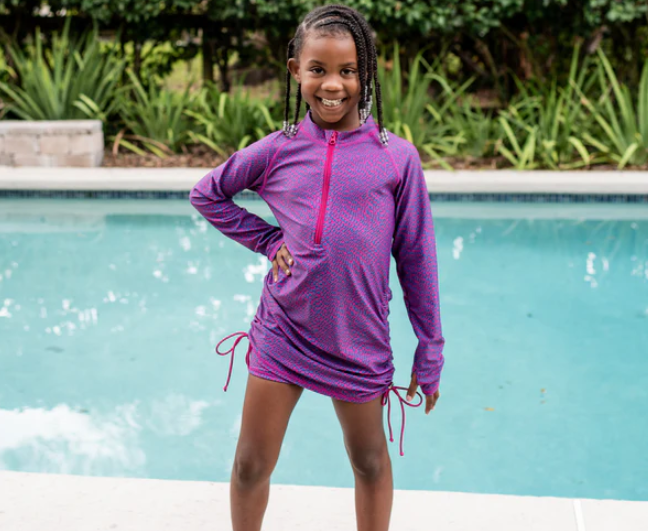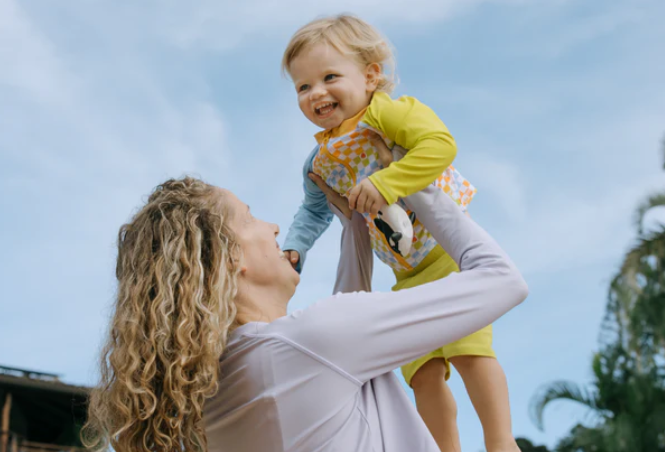
How to keep children safe around the pool
Drowning is a leading cause of death for children aged 1–4, and most of these tragedies happen in backyard pools. Pool accidents occur quickly–often in less than five minutes with adults nearby.
These accidents are preventable with the right safety measures.
Never leave children unsupervised
The Water Watcher system is simple but effective. Pick one adult whose only job is watching the pool. Even dedicated parents lose focus after a while, so when you're at parties or community pools, rotate Water Watchers every 15 minutes.
Stay within arm's reach of non-swimmers and weak swimmers. Touch supervision means you can grab your child without taking a step.
Check out our safety tips for swimmers for more ways to protect your family around water.
Teach swimming skills early
Swimming lessons with certified instructors build water confidence and essential skills. The American Academy of Pediatrics recommends starting around age 4, but kids as young as 1 can begin basic water safety.
Make sure your child masters these survival skills:
- Floating on their back for one minute.
- Treading water in place.
- Swimming 25 yards without stopping.
- Getting to the pool edges from the center.
- Stepping into deep water and returning to the surface.
But swimming lessons aren’t 100% effective at protecting children. Even competitive swimmers should be supervised at pools.
Here’s our guide on protecting your child from drowning in any water environment.
Install physical barriers and fencing
If you have a pool at home, install a fence around your pool that creates an enclosed area. The fence should be at least 4 feet high with vertical slats no more than 4 inches apart. Self-closing, self-latching gates use springs to automatically swing shut and lock every time someone passes through, so you don't have to remember to secure them.
If you have an above-ground pool, remove the ladder when you're not using it. When visiting public pools, check that safety barriers and gates work properly.
Know your pool's safety features
If you have a pool at your home, install pool alarms that detect water disturbance and door alarms for pool area entrances.
All pools should have anti-entrapment drain covers that prevent suction injuries. Home pool owners need to install and maintain these. At public pools, these are required by law but check that they're in place and undamaged.
Home pool covers add protection but don’t replace fencing. Safety covers that meet industry standards support adult weight and prevent access. Public pools have professional maintenance and safety equipment, but you should still be aware of these features and report any problems to staff.
Establish and enforce pool rules
All pools need clear safety rules posted where everyone can see them. You might add more based on your pool, but here are the 5 most important rules:
- No running on pool decks.
- No diving in shallow areas.
- No pushing or rough play.
- Adult permission required before entering water.
- Buddy system for all swimmers.
At home pools, you must set and enforce these rules consistently. At public pools, lifeguards handle enforcement, but you still need to reinforce the rules with your kids. Explain why each rule exists, because kids follow rules better when they understand the logic.
Learn CPR and emergency response
Every adult who supervises children around water should know CPR.
Home pools should have rescue equipment within reach:
- Reaching poles for extending help without entering water
- Ring buoys for throwing to struggling swimmers
- First aid kits
- Emergency contact numbers posted visibly.
Public pools have lifeguards and professional rescue equipment, but parents should still know emergency response techniques.
If your child has a water accident, rescue them and call 911 immediately. Conscious children can experience delayed drowning.
Eliminate distractions and pool hazards
At home pools, remove toys when not in use. Pool toys attract kids to water and block your view of underwater swimmers. Store them away from the pool area.
Keep pool decks clear of clutter that creates slip hazards on wet surfaces. Maintain clear pool water through weekly chemical testing.
At public pools, report safety hazards, like broken equipment or poor water clarity, to staff immediately. Clean pool areas reduce the chance of slips and falls.
What to do if your toddler falls in the pool
- Act immediately if you see a child in distress at any pool.
- Use rescue equipment before entering the water. Reach with poles or throw ring buoys from pool edges. This is often faster and safer than jumping in.
- If you must enter the water, approach the child from behind to avoid being grabbed and pulled underwater. Support their head above water and move quickly toward the pool edge.
- Remove the child from the water and immediately check breathing and consciousness. Begin CPR if they're unresponsive.
- Call 911 even if the child seems fine afterward. Secondary drowning can occur hours later when water in the lungs causes delayed complications.
- Seek immediate medical attention for any child who loses consciousness in water, inhales water, or requires rescue assistance.
Choose bright colors for better pool visibility
Swimsuit color is another safety layer alongside supervision and barriers. Bright neon colors such as yellow, orange, pink, and green create stark contrast against blue pool water, helping Water Watchers spot swimmers. These fluorescent colors reflect light and maintain visibility even in deeper sections or changing light conditions.
Avoid color choices that blend into water. Dark blue, navy, black, purple, and gray swimsuits practically disappear underwater. Dark colors absorb light instead of reflecting it, creating a camouflage effect that can delay rescue efforts by critical seconds.
The extra visibility from bright colors gives you precious time to respond if a child needs help, making high-visibility swimwear a simple but effective addition to your family's water safety strategy.
Keep your kids protected with SwimZip
High-visibility swimwear makes children easier to spot in any pool. Bright neon colors create contrast against blue pool water, helping Water Watchers track swimmers.
See what swimsuit colors are best visible in pool areas.
Our neon swimwear collection creates maximum underwater visibility.
- Girls' neon swimwear comes in bright patterns kids love.
- Boys' neon swim gear provides safety without sacrificing style.
- Even the youngest swimmers stay visible with our baby neon collection.
- Parents can join the visibility approach with women's neon swimwear and men's neon swim styles.
All SwimZip swimwear provides UPF 50+ protection that blocks 98% of harmful UV rays and carries the Skin Cancer Foundation's Seal of Recommendation.
UPF-rated fabrics offer more reliable sun protection than regular swimwear, which can lose effectiveness when wet or stretched. Pool time means extended sun exposure, so protective swimwear shields your family's skin while they focus on having fun and staying safe in the water.
Combine high-visibility, sun-safe family swimwear with smart safety practices for better protection at any pool.
Pool safety FAQ
What is swimming pool syndrome?
Swimming pool syndrome happens when chlorine mixes with sweat, urine, and body oils to create irritating chemicals called chloramines. You'll notice coughing, wheezing, chest tightness, and stinging eyes, especially at indoor pools with poor air circulation. Good pool maintenance, proper ventilation, and showering before you swim help reduce these irritating compounds and keep symptoms at bay.
Do pool covers prevent drowning?
Safety pool covers that meet official standards can prevent drowning by supporting adult weight and blocking access to water. But they're not fail-proof and should be combined with fencing, supervision, and other safety measures. You must remove the entire cover before anyone swims. Leaving it partially on creates dangerous entrapment situations where people can get trapped underneath.
What is pool poisoning?
Pool poisoning occurs when you swallow too much chlorinated water or breathe in heavy chlorine fumes from poorly maintained pools. You might feel nauseous, vomit, have throat pain, trouble breathing, or skin burns. This usually happens with over-chlorinated pools, bad ventilation, or incorrectly mixed chemicals. Get medical help for serious symptoms and make sure pools maintain proper chemical balance.
How long can a human stay in a swimming pool?
Most people can swim safely for an hour or two with regular breaks. Staying in chlorinated water too long irritates your skin and eyes, while extended activity leads to dehydration and fatigue. Cold water increases your risk of hypothermia. Take breaks every 30 minutes, drink water regularly, and get out if you feel tired, cold, or uncomfortable.
Is it bad to swim in chlorine every day?
Daily swimming in chlorinated pools can dry out your skin and hair, irritate your eyes, and make conditions like eczema or asthma worse. Competitive swimmers often deal with brittle hair and skin problems from constant pool exposure. Rinse off right after swimming, use moisturizer, wear goggles, and try leave-in conditioner to protect against damage.
Resources
Cunningham, R. M., Walton, M. A., & Carter, P. M. (2018). The Major Causes of Death in Children and Adolescents in the United States. The New England journal of medicine, 379(25), 2468–2475. https://doi.org/10.1056/NEJMsr1804754
Further reading
The difference between UPF and SPF
What colors are dangerous to wear around pools?
Keep your family safe during summer vacation



Leave a comment
This site is protected by hCaptcha and the hCaptcha Privacy Policy and Terms of Service apply.